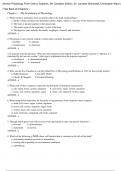Exam (elaborations)
Human Physiology From Cells to Systems 5th Canadian Edition By Lauralee Sherwood, Christopher Ward (Test Bank)
- Course
- Institution
Human Physiology From Cells to Systems, 5th Canadian Edition, 5e Lauralee Sherwood, Christopher Ward (Test Bank) Human Physiology From Cells to Systems, 5th Canadian Edition, 5e Lauralee Sherwood, Christopher Ward (Test Bank)
[Show more]



